

Www.billfitzmaurice.com. Introduction to designing and building speakers. This section is intended as an introduction to speaker building for raw beginners.
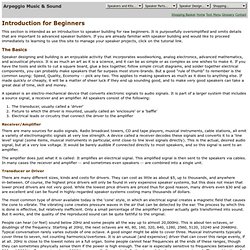
It is purposefully oversimplified and omits details that are important to advanced speaker builders. If you are already familiar with speaker building and would like to proceed immediately to learning to use this site to manage your speaker projects, click on the tutorial link. The Basics Speaker designing and building is an enjoyable activity that incorporates woodworking, analog electronics, advanced mathematics, and acoustical physics. Hoffman’s Iron Laws of Speaker Building. 1) Bass Extension 2) Efficiency 3) Small Enclosure The law is that you can only have two of these three attributes in speaker building.
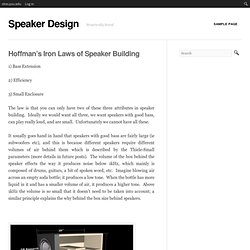
Ideally we would want all three, we want speakers with good bass, can play really loud, and are small. Unfortunately we cannot have all these. Welcome Secrets of Home Theater and High Fidelity. DIY Project # 9 - Woodworking Tools for the Do-It-Yourselfer - October, 1998 by Louis Lung (If you would like to have your DIY project published in Secrets, please E-Mail Ralph Calabria at rc@sdinfo.com.)
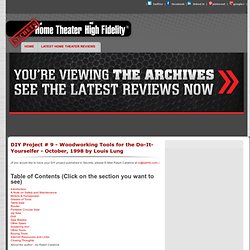
Table of Contents (Click on the section you want to see) About the author - by Ralph Calabria When I asked Lou to write this article, I was well aware of his knowledge of woodworking skills, both in furniture making and speaker building. Lou has been a woodworker for some time now, and the fine craftsmanship seen in his work is testimony. DIY Audio Speaker Box Building FAQ - Tutorial. DIY Audio Speaker Box Building FAQ - Tutorial See the Speaker Box Construction Example for more information.
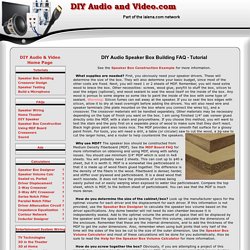
What supplies are needed? First, you obviously need your speaker drivers. These will determine the size of the box. They will also determine your basic budget, since most of the other costs are fixed. Resources - Build A Speaker. To answer some of the questions you may have concerning loudspeaker design, we have included this design primer.
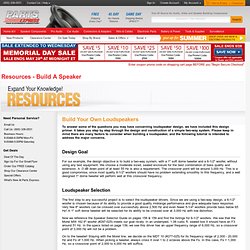
It takes you step by step through the design and construction of a simple two-way system. Please keep in mind there are many factors to consider when building a loudspeaker, and the following tutorial is intended to address the major concerns. For our example, the design objective is to build a two-way system, with a 1" soft dome tweeter and a 6-1/2" woofer, without using any test equipment. Software. The greatest thing about surfing the net is finding all the neat programs you can download.
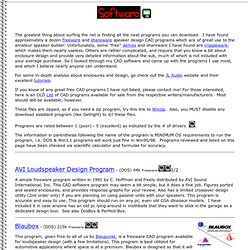
I have found approximately a dozen freeware and shareware speaker design CAD programs which are of great use to the amateur speaker builder. Unfortunately, some "free" demos and shareware I have found are crippleware, which makes them nearly useless. Others are rather complicated, and require that you know a bit about enclosure design and provide very detailed information about the sub, much of which is not included with your average purchase. So I looked through my CAD software and came up with the programs I use most, and which I believe nearly anyone can understand. For some in-depth analysis about enclosures and design, go check out the JL Audio website and their excellent tutorials.
If you know of any great free CAD programs I have not listed, please contact me! These files are zipped, so if you need a zip program, try this link to Winzip. Boxnotes - Free Speaker Design Software. Use this free software to assist you in deciding the actual dimensions for your enclosure After using software such as WinISD to chose the volume and port sizes for your new speaker, turn to Boxnotes to find the best dimensions for your enclosure.
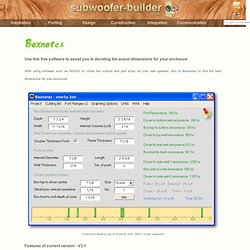
Screenshot showing use of Imperial units. Metric is also supported Features of current version - V3.1 Take into account the extra volume taken up by your ports, bracing and driver Check the minimum dimensions required to house your driver Quickly see the effect of changing port parameters Spot problem resonances and adjust your dimensions to minimise their impact Print your cutting list, including optional allowance for trimming with router Save your work in boxnotes project files, including comments Supports both Imperial and metric measurements Generate a text based report containing your choice of information Boxnotes is written in Visual Basic 6 and runs under Windows. Additional screenshots Minimum size check screen.
Speaker Workshop. AJ Audio Subwoofer Box Enclosure Design Software - Sub Speaker Cabinet Building Program Downloads. Providing subwoofer design software programs for solving the required calculations for custom bandpass, sealed and vented box cabinet designs.
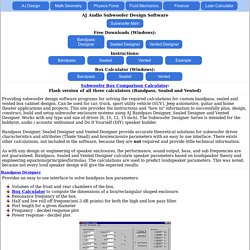
Can be used for car, truck, sport utility vehicle (SUV), Jeep automotive, guitar and home theater applications and projects. This site provides the instructions and "how to" information to successfully plan, design, construct, build and setup subwoofer enclosure systems using AJ Bandpass Designer, Sealed Designer and Vented Designer. Works with any type and size of driver (8, 10, 12, 15 inch). Building a Do-It-Yourself Loudspeaker Design. It is nearly impossible to justify, to the average person, spending tens of thousands to millions of dollars on loudspeakers for personal enjoyment.
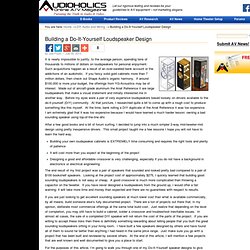
Such acquisitions happen as a result of an over-swelled bank account or the addictions of an audioholic. If you fancy solid gold cabinets more than 7 million dollars, then check out Shape Audio’s organic harmony. If around $100,000 is more your budget, the offerings from YG-Acoustics may be of interest. Made out of aircraft-grade aluminum the Anat Reference II are large loudspeakers that make a visual statement and initially interested me in another way.
Before my eyes were a pair of very expensive loudspeakers based loosely on drivers available to the do-it-yourself (DIY) community. After a few good books and a bit of forum surfing, I decided to jump into a much simpler 2-way mid-tweeter-mid design using pretty inexpensive drivers. The first step in developing a loudspeaker is obviously deciding what the goals are. DiyAudio. LinearTeam. WinISD Is freeware speaker designing software for Windows 9x/NT environment.
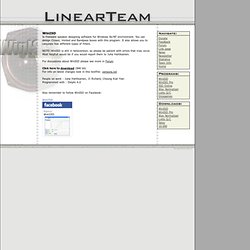
You can design Closed, Vented and Bandpass boxes with this program. It also allows you to calculate few different types of filters. NOTE! WinISD is still in betaversion, so please be patient with errors that may occur. Most helpfull would be if you would report them to Juha Hartikainen. For discussions about WinISD please see more in Forum Click here to download (840 kb) For info on latest changes look in this textfile: versions.txt People on work : Juha Hartikainen, JJ Richard, Choong Kiat Yian Programmed with : Delphi 4.0. Parts Express Speaker Projects. Subwoofer System Kits in the Speaker Components Department at Parts Express. Speaker Kits in the Speaker Components Department at Parts Express. DIY Speaker Links - undefinition. There are a lot of personal websites out there on the subject of speaker building--with varying levels of helpfulness, depending on your ability level.
Remember, though, that just because some website or book says that their way is the correct way to build speakers does not mean that it is the only way--and it doesn't even mean that they are right. Speaker building is an art, and like any art form, everyone's approach is a little different. In other words: don't be afraid to try someone's advice; but in the end, you have to do what works for you. Getting Started in Audio DIY Just getting started? DIY Subwoofers at Home Theater Forum and Systems - HomeTheaterShack.com. DIY Speakers at Home Theater Forum and Systems - HomeTheaterShack.com. Tech Talk Forum.